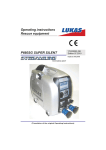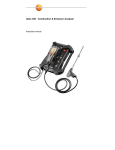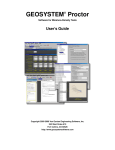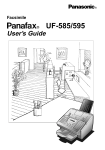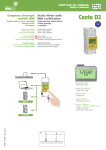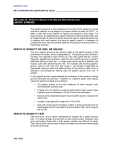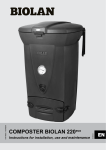Download BURNiT PM 15kW Specifications
Transcript
Best Practice Guide Wood Burning Technologies for Irish Consumers Objectives of this Guide? Whether installing a wood boiler in a new or existing dwelling, the initial capital investment will generally be greater than for a conventional boiler. Modern wood burning technologies might be relatively new to you and it is possible that you may have already gathered some useful information with regard to specific products and systems. The aim of this guide is to provide you with an insight into wood fuelled boiler systems that will allow you to can make more informed decisions when considering purchasing a wood burning technology. The guide has been organised into the following sections: Introduction Section 1: Technology Overview Section 2: Fuels Section 3: Feasibility and Design Section 4: Procurement and Purchase Section 5: Boiler Installation Section 6: Operation and Maintenance The sections run in a similar order to what might be encountered when planning your installation. It is recommended that you read all the sections as it will give you a good knowledge of the processes involved and allow you to make more informed decisions with regard to: Choosing the right system; and After installation, how to operate the system efficiently. Introduction Heating with wood is not a new concept in Ireland. Up to the recent past, wood was most commonly burned in log form in an open fire. The fire would also, in most cases, have a back boiler to provide central heating and hot water as well as space heating in the room itself. Open fires create a special atmosphere in a room and for that reason are still very popular in Ireland. However, they are also very inefficient, with approximately 70% of the energy available in the wood wasted up the chimney. Modern closed appliances such as stoves with built-in back boilers can offer efficiencies of 90% or more, while at the same time recreating the ambience of an open fire. This guide does not cover room heating stove appliances (i.e. stove appliances that heat air only), but rather concentrates on wood burning technologies that provide whole house heating solutions. For further information on wood stoves, please see the SEAI REIO consumer guide for wood burning stoves. Technology Overview For domestic installations there are three common types of boilers: Wood pellet boilers Wood chip boilers Wood log / briquette boilers Combination boilers are also available which can burn one or more of the above fuels. Wood logs have always been used in Ireland as a fuel source. Traditional fireplaces offer an efficiency of approximately 30%, which means that less than one-third of the energy available from the wood is converted into heat for your house, with the remaining 70% being wasted. Modern wood burning appliances are designed to burn wood more efficiently, with the advantage that heat can be distributed through existing radiator or underfloor heating systems. Wood pellets and wood chip boilers offer the convenience of operation offered by oil and gas boilers, with the advantage of being carbon neutral sources of fuel. Due to the fact that wood pellets and chips are easily transferred from fuel store to the boiler via auger systems and / or suction feed systems, it means that a new wood pellet / chip boiler installation is effectively a “plug and play”, i.e. can easily be integrated into an existing heating system. Modern wood boilers are highly efficient (over 90%) and clean burning. As mentioned, wood boilers work well with radiator and underfloor heating systems, this is something to keep in mind if you are looking to replace an existing oil or gas boiler system. Wood pellet boilers Most wood pellet boilers are fully automatic in operation. Fuel handling is convenient and requires a relatively small storage volume due to the high energy density of the pellets. Storage can be adjacent to the boiler itself or in separate fuel store. In both cases a feeding mechanism (screw / auger / vacuum feed) is used to transport the pellets from the store to the boiler. Pellets are automatically fed into the burn chamber with the boiler continuously controlling the quantity of pellets coming through. Similar to conventional gas and oil boilers pellet boilers generally have automatic ignition and continue to operate without manual intervention. “Higher spec” boilers are self-cleaning eliminating all but the need for periodic ash removal from the ash pan. A small amount of ash is generated (usually less than 1% of the fuel input by weight) that needs to be removed on a regular basis. Pellet store and feed mechanism Wood pellet boiler installation Wood pellet boiler cutaway Wood chip boilers Wood chip boilers are very similar to wood pellet boilers; in fact, many boilers can burn both fuels. Typically wood chip boilers are found in larger scale installations, with wood pellet the preferred option for smaller domestic installations. Chip boilers are generally automatically igniting and continue to operate without manual intervention. Again, self cleaning options are available. Similar to pellet boilers, a small amount of ash is generated that needs to be removed periodically. The main advantage of chips over pellets is that the fuel and running costs are cheaper. Tractor powered wood chipper Chip store, chip agitator and boiler feed Wood chip boiler installation Wood log / briquette boilers Modern log boilers have very high efficiencies. Wood log boilers differ from most wood pellet or wood chip boilers due to the fact that wood logs are manually loaded however some systems have an integrated store within the boiler so that only intermittent manual loading is required. Log boilers can be an advantage where a supply of clean wood is freely available. In most wood log systems, a large hot water storage tank or buffer cylinder is required. The reason is because wood log boilers burn the entire contents of the fuel chamber in a single burning period, the heat must be “stored” so it can be available when required. Wood logs and briquettes can also be used in open fires. While this is preferable to fossil fuels from an environmental perspective, open fires tend to have very low efficiencies and controlled combustion in a boiler is a much more efficient method of producing heat. A specific type of wood log boiler, a gasification boiler, has very high efficiencies and is readily available in Ireland. Combination boilers are also available which offer a “dual fuel” burning option, for example wood log and wood chip / wood log and wood pellet. Wood gasification flame in secondary chamber Wood gasification boiler, plus buffer cylinder and expansion vessel Wood gasification boiler cutaway Fuels What are wood fuels? Today, wood heating is a cost competitive, highly comfortable and environmentally sustainable alternative to fossil fuel. Refined wood fuels are available in a variety of forms including logs, briquettes, chips and pellets. The most efficient way to use wood fuels is in a closed system. Home produced wood fuels are independent of international energy prices and offer Irish consumers a secure, indigenous and carbon neutral source of energy. Why wood fuels? High energy content, two kg of wood is approximately equivalent to one litre of oil in terms of energy content Grown locally supporting local economies Fully automatic heating system options available for wood pellet and wood chip boilers Wood fuel costs are more stable compared to fossil fuels Wood pellets are a standardised high quality, high energy content fuel Easy to handle, transport and store Environmental advantages for a lowered CO2 impact for life-cycle of systems Wood pellets Wood pellets are a popular renewable fuel with a growing number of Irish manufacturers and suppliers importing pellets. Wood pellets are produced from sawdust, shavings, bark or chips by drying and pressing with steam. During this process, a compound found in wood called lignin acts as a natural binding agent which holds the pellet in shape, and also gives the pellets their distinctive glossy sheen. They are compact, easy to store and are used for fully automatic heating in pellet boilers or stoves. There is a small carbon footprint associated with the manufacture and transportation of pellets (approximately 2% of the energy content of the fuel) but this is more than compensated for as the wood itself is carbon neutral, and the carbon intensity of wood pellet production is negligible in comparison to the carbon footprint of fossil fuel production (pre-burning) i.e. sourcing, drilling, refining and transportation. Wood chips Typically, chips are sourced from sawmill, forestry by-products or from short rotation forestry (SRF), fast growing trees, such as willow grown for the purpose of creating wood chips. Typically, these trees grow for seven years before they are first thinned and harvested. Wood chips are produced by wood chippers, which use sharp chopping blades to cut the bulk wood to the required chip size. The size of the chips is dependent on the setting of the blades in the chipper. Wood chipper in action Typically wood chips used in domestic boilers should possess the following characteristics: A uniform size 8-15 mm Maximum 30% moisture content (the dryer is better) High energy and low ash content Free of dust and fungal spores Wood chips are generally more common for non-domestic heating applications. Another consideration regarding wood chip storage is the feeding mechanism for bringing the wood chips from the fuel store to the boiler. A mechanical stirrer is required in the store to avoid bridging (whereby chip outlet is blocked by larger pieces) of the chips as they are not as uniform in terms of shape. The minimum storage volume also needs to be larger when storing wood chips because the energy density of the chip is less than that of pellets, and the bulk density is also smaller (approximately 500 kg of chips per cubic metre (m3) storage space compared with 650 kg of wood pellets per m3 storage space). Wood logs / fire wood These are generally manufactured from forestry by products. If you have a source of clean wood, cut and store the wood (to season and dry the fuel) and manually feed into the boiler as required. With regard to wood burning technology, boilers can be divided into two main categories: Overfire boilers - these are the most common boilers, wood combustion in these boilers occurs throughout the entire fuel batch from the bottom up for example like an open fire Gasification boilers or “downdraught” log boilers - in these boilers, the wood pile is “smouldered” at the very bottom by pushing air down through the wood batch. The smouldering wood is then converted to wood gas as a result of this process. The gases are then ignited in a secondary chamber to create a high temperature wood gas “jet” flame. Wood gasification boilers offer very high efficiencies. Wood briquettes Produced from compressed sawdust (similar to wood pellets) they are usually round in shape (similar to a wood log but with a higher energy content and more uniform in shape). Briquettes can measure 25100mm in diameter and between 10-200mm in length. Due to their large size, they are not suitable for fully automatic feed in small boilers. Suppliers of wood fuels Given the increasing number of domestic and commercial wood fired boilers in Ireland there is now a growing network of fuel suppliers. Updated lists are available on the SEAI website – the list mainly includes wood pellet and chip suppliers; however some briquette and log suppliers are also listed. The list is not an endorsement of suppliers and there may be other suppliers in your local area. Wood fuel costs Costs vary by fuel type and from supplier to supplier. The quantity of fuel ordered also has an impact on cost. For example, wood pellets supplied in bags are almost twice as expensive per kg compared to bulk deliveries. It is recommended where possible that you identify local suppliers and obtain quotes for supply. For bulk or larger deliveries it may be possible to stock up in the summer when prices are often lower. See SEAI fuel cost comparison sheets: http://www.seai.ie/Publications/Statistics_Publications/Fuel_Cost_ Comparison/ which provides indicative costs per kg. How are wood fuels stored and supplied? Stored in recommended conditions wood fuels do not degrade over time. The main criteria are to ensure the fuels are kept under cover and shielded from all rain, including moisture penetrating the storage area. For logs and chips, storage under cover will generally reduce moisture content and preserve the energy content (calorific value) of the wood. For pellets, it is recommended that they are stored in a place where the moisture content can be kept to a maximum of less than 10%. For wood logs which are to be used in high efficiency wood log gasification boilers, it is recommended that the moisture content of the logs is below 20%, which means that the logs must be dried for approximately one year. For standard wood log boilers, wood with a moisture content of up to 30% is usually acceptable. The wetter the fuel, the less efficient the burning process and the greater the risk of tar build up occurring. Typical wood fuel storage solutions include: Wood pellets - concrete store, pre-fabricated storage tanks (metal or plastic), fabric stores supported by metal frames, bagged pellets (can be stored practically anywhere) Wood chips - concrete stores next to boiler room, storage tanks (metal or plastic, above / below ground) Wood logs /briquettes - stacked (preferably under cover for at least one year before use) Clockwise from top left: Wood logs – stacked and covered; Fabric wood pellet store; Outdoor wood pellet storage (plastic example); Outdoor wood pellet storage (metal example). How do I Estimate Annual Wood Consumption? Where a dwelling has a Building Energy Rating (BER), for example when built, sold or rented, the accompanying advisory report can provide some useful information on estimated energy consumption for heating and hot water, as can existing oil or gas bills if there has been an old boiler in place previously. If the information is available this is exactly what you need to calculate projected wood consumption. Example 1: Calculating wood consumption from an existing oil bill – (using wood pellets) Oil bill - shows that you use 2,000 litres of oil per year Energy content of oil = 10.55 kWh/litre, therefore total “oil” energy used = 10.55 x 2,000 = 21,100 kWh per year Oil boiler efficiency = 80%, therefore actual dwelling heat requirement = 21,100 x 0.8 = 16,880 kWh New wood boiler efficiency = 90%, therefore “wood” energy required to heat dwelling= 16,880 / 0.9 = 18,756 kWh Energy content of wood pellets = 4.8 kWh/kg, therefore 18,756 kWh of energy required would mean 18,756 / 4.8 = 3,908 kg/yr = 3.908 tonnes of wood pellets per year. Suppliers and installers should also be able to advise you on projected annual fuel consumption of the boiler. If you know the installed or planned capacity of the boiler in kW, multiplying this figure by the number of running hours per year will give you the number of kWh of fuel required. This can then be converted, in a similar fashion to example 1 above, into the number of tonnes required, and based on the energy content of the fuel being used. Below are two examples which detail the calculations for identical situations using different boiler types: Example 2 - Wood pellet boiler Wood pellet boiler - 20 kW output, 90% efficiency, running for 1,750 hours per year (typical) kWh required = 20 / 0.9 x 1,750 = 38,888 kWh per year (note divide the kW output of the boiler by the efficiency to get the actual fuel input energy required) Wood pellet energy content = approximately 4.8 kWh/kg @ 8% moisture content. Therefore: Annual pellet requirement = 38,888 / 4.8 = 8,101 kg = 8.101 tonnes. Example 3- Wood gasification log boiler For a wood log boiler, an additional requirement is a buffer cylinder. Approximately 55 litres of buffer cylinder capacity is required per kW output of the boiler. Wood log gasification boiler - 20 kW output, 90% efficiency, running for 1,750 hours per year (typical) kWh required = 20 / 0.9 x 1750 = 38,888 kWh per year (note divide the kW output of the boiler by the boiler efficiency to get the actual fuel input energy required) Wood log energy content = approximately 4.0 kWh/kg @ 20% moisture content. Therefore Annual wood log requirement = 38,888 / 4 = 9722 kg = 9.722 tonnes. Note: Typical energy contents of wood fuels are given in Table 1. The SEAI domestic heating cost and carbon comparison tool can be used to analyse the possible fuel consumption and running costs per year of different heating sources in a dwelling. Quality Standards for Wood Fuels The Committee Europeen de Normalisation (European Committee for Standardisation) (CEN) has published a number of standards for solid biofuels. These standards have been adopted by the National Standards Authority of Ireland (NSAI) and therefore represent the default case in Ireland. Other standards are common in the EU and represent approximately equivalent standards, for example Germany DIN 51731 (pellets & briquettes); Austria ÖNORM M 7135 (pellets & briquettes); Swedish Standard SS 187120 (pellets) and SS 187121 (briquettes); French Pellet Club Voluntary Quality Charter. The standards cover characteristics including raw material used, dimensions, moisture and energy content to ensure high quality, standardised fuel. Fuels that do not conform to the European standards may contain contaminants that cause harmful emissions and damage your heating system. It is therefore recommended that you check your fuel conforms to one of the above standards or that your supplier can reassure you that the fuel conforms to an equivalent standard, for example in Canada or USA. In countries where wood fuels have been established for many years, for example Austria, it is common to find “markers” in the fuels. The marker usually contains a serial number that can be traced to a manufacturer or supplier. Pellet marker used in Austria. Moisture content Pellets Chips Logs Briquettes 8% 30% or less 40–60% fresh 8% dried Ash content 0.5% 1-3% 0.5 % 0.5% Dimensions 6-8mm diameter 10-20mm length 3-45mm (variable) Variable 65mm diameter 25-200mm length Density 652 kg/m3 214 kg/m3 (variable) 350 kg/m3 (slightly variable) 450-550 kg/m3 Specific volume 1.53 m3/tonne 4.67 m3/tonne 2.86 m3/tonne 1.82-2.22 m3/tonne Energy content 4.8 kWh/kg 3.4 kWh/kg 4.0 kWh/kg @ 20% moisture content 4.7 kWh/kg Source Bioheat II Calculator Bioheat II Calculator WFBIP WFBIP WFBIP Table 1: Typical wood fuel characteristics for domestic use One of the most important properties of wood which has an influence on its energy content per kg (calorific value) is the moisture content (see below). Net Energy Content (kWh/kg) EnergyEnergy Content Vs Moisture Content Vs MoistureContent Content 5.5 5.0 4.5 4.0 3.5 3.0 2.5 2.0 1.5 1.0 0.5 0.0 0% 10% 20% 30% 40% Moisture Content (by weight) 50% 60% 70% 80% Effect of moisture content on net energy content of wood fuel – the chart highlights the useful energy content of the wood decreases significantly as the moisture content increases. The energy content of the “dry” element (or dry matter) of the wood remains the same but as the moisture content increases you are effectively purchasing more water, adding extra weight, and therefore the energy per kg is reduced. The Irish Wood Fuel Quality Assurance Scheme (WFQA) The Wood Fuel Quality Assurance Scheme (WFQA) is an Irish wood fuel quality scheme. The main objective of the WFQA is to facilitate and ensure best practice operations throughout the wood fuel supply sector in Ireland. Best practice in wood fuel supply is achieved, by providing and implementing a comprehensive and cohesive framework for wood fuel sampling and certification of the organisation involved in the manufacture and supply of quality logs, chips, pellets and briquettes to the Irish market. Feasibility and System Design If you are considering installing a wood boiler it is recommended that you examine the possibilities from the point of view of cost and technical perspective. This does not need to be a complex process, the information below will help. If it is deemed feasible to go ahead with a wood system, it also needs to be designed so that it integrates with other systems in the dwelling. This will often be a job for the installer / supplier, but it helps to have a basic knowledge of how the process works, so that the design proposals can be examined and allow better informed decisions to be made. Note: For new dwellings, the Building Regulations 2008 Part L requires a proportion of primary energy to be supplied by a renewable source. Wood boilers and other wood burning appliances can help meet this minimum renewable energy requirement and also influence the Building Energy Rating (BER) results for dwellings. Any house with the space for the boiler and associated items such as accessibility for fuel delivery, fuel store and boiler cleaning/maintenance is suitable for wood heating. In some cases, however, a wood stove might be more practical when space or accessibility is an issue. Potentially every project is different, and therefore it is recommended that you contact a BER assessor to accurately calculate the heat requirement of your dwelling. You will then have an indication of the boiler size required. Feasibility General Considerations Space available Integration with heat distribution system and additional heat sources Availability and cost of fuel Economic Feasibility Compared to gas or oil Establish annual consumption, for example heat load calc x 1,500 full load hours, information available from DEAP, RET screen Data availability, for example SEAI fuel cost comparisons, quotes from supplier Displacement of fossil fuel equipment, for example cost of oil boiler taken off total biomass system costs Fuel cost escalation to calculate pay back System Design General advice on best practice design features includes: I nsulation of pipe work - pipe runs can be a major source of heat Ioss; make sure all pipes and fittings are appropriately insulated. Best practice is to insulate the entire length of primary pipe work (the main pipes running between the boiler and the heating system, including the hot water cylinder). This will ensure that minimal heat loss through the pipe work and will guarantee that the heat is delivered to your living space or through the taps as hot water. Ash - when wood burns, ash is inevitably produced (in a boiler, this is usually less than 1% of fuel input). The ash pan needs to be emptied on a regular basis. The frequency will depend on the boiler type, the fuel and also the amount of time the boiler is used. Wood ash can be used in the garden but care must be taken that the ash contains no toxic elements. Controls – control of any boiler system is crucial to the efficient operation of the system. A wood boiler is no different – many higher quality boilers come with integrated control panels that are able to enhance the efficiency of the system. Characteristics of a best practice control system include: Zoning of the heated spaces, for example living and sleeping areas* Separate zone for the hot water tank* Thermostatic control of space heating and hot water (i.e. boiler interlock to prevent the boiler firing up when no heat is demanded from the hot water or space heating zones Weather compensation Delayed start thermostats or optimisers Multi-channel controller capable of setting on-off times for each zone independently End-user time and temperature strategy for the week (this depends on the occupancy patterns of the homeowners) *Note: See section 1.4.3 of the Technical guidance document of Part L of the 2008 Building Regulations for guidance on “zoning” of a dwelling. Heat Storage For boilers without automatic ignition, for example wood log boilers that would burn a chamber of fuel in a single burning period, it is important that the heat is used efficiently. The heat must therefore be stored somewhere so that it is available when required. A buffer (or accumulator) tank is a heat storage vessel that is connected to the boiler for this purpose. The buffer tank is then connected to the heating and hot water systems in the dwelling. Some technical considerations include: Compared to oil or gas, wood boilers take a little longer to start up and shut down, for example five to 10 minutes. Boilers do not operate as efficiently during start up and shut down. By using a buffer tank the number of start ups and shut downs is considerably reduced thus increasing efficiency. Some wood pellet boilers can vary their heat output to match the heat demand of the dwelling, so a buffer tank might not be necessary in these situations. A buffer tank effectively increases the heat load the boiler can cope with for example a 10 kW boiler can cope with the design heat loads of a 13 kW boiler. This is because the heat can be stored up over a relatively long period of time. As the name suggests, the tank “buffers” the system against peak demands. In a direct acting system the boiler needs to be capable of dealing with all demand at the same time, for example heating and sudden demand for hot water. As the buffer tank needs to maintain temperature of the water over a long period of time, it should be well insulated, for example 75mm–100mm of factory fitted insulation. Wood boiler (left) and buffer tank (right) The size of the buffer cylinder depends on the capacity of the boiler. It is recommended that for every kiloWatt (kW) of boiler power output you have 55 litres of buffer cylinder storage. For example for a 15 kW wood log gasification boiler, the recommended buffer tank size would be approximately 15 kW x 55 = 825 litres. Manufacturers / suppliers may recommend a variation on these numbers depending on the system. Burn back Protection Burn back refers to the spread of fire back through the fuel line and into the fuel store. This phenomenon is a risk (if no prevention measures are in place) in boilers with auger fed fuel (most commonly chip and pellet). Burn back protection refers to measures put in place between the fuel store and the burn chamber to prevent a fire spreading between the two areas. Higher quality systems would often use two or three devices to ensure a high degree of safety. There are two main types of measure to prevent burnback: Physical measures Interruption such as a “drop” (see below) Shutters - these clamp shut and block the fire path Rotary pocket feeders - similar to a revolving door principle highlighted below “Designed to fail” measures Melting tubes - designed to melt in the event of fire spreading through the fuel line (see below) Water dousing systems in the fuel feed line and fuel store (designed to quench fire) All boiler systems have temperature limit thermostats which act as a first line of defence against burnback. However, these limit thermostats on their own do not provide sufficient protection against burn back. Burn back Protection Measures Interruption design – pellet drop Twin-auger design with rotary pocket feeder Boiler showing melting tube(in blue) Pressure Relief Valves All heating systems incorporate pressure relief valves. In the event of a very high pressure build up in a sealed system due to a malfunction, the pressure relief valve will open up to relieve excess pressure and prevent damage to the system. These valves should be routed to the ground or a drain/collection vessel and installed in a suitable location so as to cause minimal damage if they are called into action. Ventilation / Exhaust A boiler must have a secure air supply for safe operation. This can either be in the form of a controlled dedicated air supply directly to the appliance or in the form of a permanent ventilation opening to the space in which the appliance is located. Best practice is to rely upon dedicated ventilation and not on air infiltration and / or leakage into the space. The size of the opening depends on the size of the appliance. Your supplier should be able to size this correctly. In addition, extractor fans may interfere with the operation of the appliance causing smoke to spill out of the appliance to the room. The flue is critical to the safe and efficient operation of a wood boiler. It is the flue which helps the boiler to breathe. Its task is to evacuate the exhaust gases, and to draw in new air to keep the fire burning. Even if a boiler has a mechanically assisted draft function, it is still very important to ensure that the flue is sufficiently high to provide natural draft in the event of a power outage. Technical Guidance Document Part J of the Building Regulations provides guidance on ventilation and flues for solid fuel appliances. Mounting Base A boiler should be placed on a hard, level and non-combustible surface. Typically this would be a concrete floor or base that is purpose made for the boiler. Avoid placing on floors covered with lino or carpet, suspended timber floors or floors finished with timber. Air to Fuel Ratio Control (Lambda Control) Boiler efficiency is influenced by the amount of air introduced into the combustion process. Too little air results in incomplete combustion and loss of efficiency as not all the energy in the fuel is being extracted. Too much air provides complete combustion but wastes energy heating the excess air which goes out the flue rather than being used where it is wanted. It is therefore always a primary objective to get the ratio of air to fuel just right. One way this is achieved is by setting an air inlet to the boiler, typically during servicing. While this often works well with gas or oil systems because the fuels are very uniform and the characteristic operation of the boiler does not change significantly over the course of a year, wood boilers, especially chips or logs are subject to variations in the fuel, e.g. different woods have different net energy contents requiring different air fuel ratios. The net energy content of the wood may therefore vary over time with different batches of deliveries. Lambda control overcomes the problem of fuel energy content fluctuations. A lambda sensor measures the oxygen content of the flue gas and makes adjustments to the air supply rate based on the readings it gets. In this way, maximum efficiency is maintained at all times in this respect. It’s a bit like having a service engineer in constant attendance to adjust the air supply rates. Lambda control is recommended as best practice. Some higher end boilers offer lambda control as standard. Middle range boilers often have this as an optional extra. Heat Exchanger Cleaning The efficiency of a boiler is strongly influenced by the ability of the flame / hot gas to transfer heat to the water in the heat exchanger in the boiler. A build up of soot on the heat exchanger surface will impair a boilers ability to transfer heat to the water. As a result more heat will escape through the flue and the overall boiler efficiency will reduce. Wood fuel boilers are more prone to soot build up on the heat exchanger than oil or gas systems. With oil or gas the build up of soot is minimal and half yearly or annual servicing is normally more than sufficient to prevent efficiency losses in this respect. The same approach for wood fired boilers is not sufficient as soot deposits build up much quicker. There are generally two approaches to dealing with this: Manual Cleaning - the heat exchanger requires regular cleaning manually. To do this the end user needs to open up the front of the boiler and brush out soot deposits on a regular basis, e.g. once per week or less frequently when the boiler is used less. Boilers that require manual cleaning are usually available from the less expensive end of the market. Automatic Cleaning - the heat exchanger still requires regular cleaning but this is done automatically by internal devices in the boiler. Generally this is achieved by springs mounted vertically within the heat exchanger that are gently vibrated using a cam system. This causes the springs to make contact with the heat exchanger and “knock off” the soot build up which are collected at the bottom of the boiler. This is much preferred over manual cleaning as it is automated at regular intervals and ensures peak heat exchanger efficiency is maintained. Although end users may have good intentions initially about cleaning a boiler that needs manually cleaning, the end user will often lessen the frequency or sometimes forget to clean the exchanger. This will cause saw tooth dips in efficiency of the boiler below its rated efficiency. Automated cleaning devices of course attract a price premium. Boilers in the middle to top end cost brackets tend to have automated cleaning mechanisms. In terms of best practice, it is recommended that automatic cleaning is specified as a minimum requirement. Location of Boiler and Boiler Room Specification Domestic wood boiler systems are bulkier than traditional oil or gas systems, so one of the main concerns is space. Wood pellet and chip boilers require a large fuel store for pellet boilers, this is often in the same room as the boiler, and wood log systems will more than likely have a buffer tank installed. If the boiler room is remote from the dwelling, it is important that any pipes running under the soil are insulated. Pre-insulated piping is available (often referred to as district heating pipe) and it is recommended as best practice that this type of piping is used for external runs. Thermal Mixing Valve (Anti Scald Valve) Best practise calls for the fitting of a thermal mixing (anti-scald) valve on a hot water system. With the current recommendation to store hot water at 60°C to prevent the growth of legionella bacteria it is becoming more of a consideration to install thermal mixing valves. A thermal mixing valve ‘mixes’ cold and hot water together to ensure the water temperature is safe for people to use. This is not exclusive to hot water systems heated by wood, it is important for all hot water systems. Thermostats and Timers The control of the boiler on/off times and the temperature in each of the rooms is very important. In order to read room or zone temperatures and to allow the homeowner to set them, a thermostat is required. A dwelling will usually have one “master” thermostat per zone. A master thermostat is a thermostat which can directly call on the boiler for more heat. A “slave” thermostat therefore is a thermostat which does not call on the boiler, but can still adjust the temperature in the room if the boiler is running. As well as temperature, it is important that the on and off function of the boiler is timed as well. Some thermostats now are digital and have built-in timers also. Flues A flue is the exit point for the exhaust of a boiler. It can be installed through a chimney or outside of the building. The flue must be installed to current building regulations. Some general things to look for include: Is it above the eaves line by about 1 meter or 600mm if coming out near the roof apex? It is twin walled and insulated It has a cowl or hood on top to help prevent down draught It should be separated from any combustible material The top of the flue is positioned away from any windows or roof lights that might let flue gases back into the building The flue outlet is positioned away from walls and other surfaces that might be stained by the flue gases Size of Wood Fuel Store In general, and within reason, the larger the storage the better, this means less frequent fuel deliveries are required and prices tend to be more favourable. Bulk - for a typical house a minimum four 4 tonnes storage capacity is recommended for chips (18–20m3) and pellets (7– 8 m3). This allows advantage to be taken of typical minimum delivery quantities (for example three tonnes in the case of pellets) at the most advantageous cost. Minimum delivery amounts of chips will vary from supplier to supplier. Bagged - mainly applies to pellets. Use of bagged pellets normally indicates that demand is low, for example very low energy or passive house or that they are used for a secondary heating system (room heating only stove). There are no particular guidelines on stored quantities required but this may be influenced by available covered space, quantity discounts, whether they are delivered or self collected, predicted annual demand, frequency of delivery required and distance to preferred supplier. It would normally be sensible to have storage available for 10–20 15 kg bags to satisfy most of the above variables. Briquettes and Logs Again, larger purchases will prove more cost effective where the fuels are delivered by the supplier. However, where these fuels are readily available in the local area, for example from the local co-op, and collected by the end user it may be possible to maintain a smaller stock. In the case of wood logs where you have your own supply the storage should be dictated by the quantities estimated for annual use, i.e. store sized for annual consumption and rotated to allow drying. Suppliers and installers of equipment should also be able to advise you on sensible fuel storage requirements based on knowledge and past experience. Delivery and Access As with all solid and liquid fuels, where on-site storage is normally required, wood systems require storage areas for the fuels. Deliveries can range from self-collection of bags to bulk delivery by lorry. Bagged pellets do not usually cause any delivery or access problems in the case of self collection. But if you buying large quantities of bagged pellets that are delivered by lorry, talk to your supplier first about the size of the delivery lorry and ensure that the lorry can get to within a sensible distance of the storage location. Note on bulk delivery: Bulk delivery requires careful consideration. Delivery vehicles are typically 10–15 tonne lorries that need to be able to get to within a reasonable distance of the fuel store, for example within 15–30 meters so the fuel can be “blown in”. Blown deliveries are common for bulk pellets. Tipped deliveries are preferred for chips but blown deliveries are still possible but less common. Suppliers might prefer to tip both chip and pellet fuels as this is quicker than blowing and they may give a better price on this basis. In some mainland European countries, for example Austria, it is common place for houses to have basements and this facilitates tipped deliveries. In Ireland basements are a rarity and add additional construction costs. For this reason, blown deliveries are far more common. If you are designing a house it is worth giving consideration to a basement boiler room and store as it is a very tidy solution. It is also worth taking advantage of site topography in some cases, for example where the slope of the site facilitates ramping to the store. Equipment Specifications - Checklist The boiler should be registered as assumed fit for purpose for the purposes of Building Regulations Part L 2008. Cross-check for boiler listing on the HARP database– for Building Energy Ratings? Find out how “hands-on” the boiler system will be. i.e. does the boiler have an automatic cleaning and ash gathering function? If not or if partially automatic, then how often should it be cleaned? What should be cleaned and what is the correct method of cleaning (heat exchanger and combustion chamber are usually the main concerns)? How often should the ash pan be emptied? Boilers should have a minimum warranty of two years. Ask your supplier about the recommended maintenance (servicing) For newer airtight dwellings, ask your supplier if a dedicated air supply can be routed to the boiler from outside. Also, remember that if the boiler can burn fuels other than wood, then it will not qualify as a renewable heating product which can be used to meet the renewable requirement of Part L 2008 of the building regulations. Procurement and Purchase of a Wood Boiler At this stage you will have hopefully decided which type of boiler best suits your needs, and you will have a basic knowledge of how the system might be configured. The process of sourcing and buying a system is the next step. High efficiency makes economic sense Wood boilers use the latest technology to control the amount of fuel and air released to the burner. Typical costs of boiler and installation range from €5,000 to €15,000 depending on the size of the house, heat demand, boiler type, boiler functionality and fuel store type. Initial investment costs will be higher than for gas or oil systems but the running costs will generally be lower. Wood boilers compete especially well against oil and LPG systems where the fuel costs are high and costs continue to increase. What to look for in a best practice system Efficiency of 85% or higher CO2 emissions less than 200 mg/m3 After sales service contract Automatic cleaning Good quality burn back protection CE Marked Operators manual supplied in English Fuel storage for 3-4 tonne of wood pellets per year (allow up to 50% more for wood chips due to lower energy density) Pellet storage space of 2 X 3m floor area & 2.25m height (for domestic 15 kW boiler) Boiler room size of 2m X 2m X 2.5m height Installer and supplier are trained professionals Investment return Expected costs and pay backs will vary, however wood boilers typically cost between €5,000 and €15,000 supplied and installed. The pay back time for such an investment depends on the initial cost and also on the cost of the wood fuel, compared with the savings per year you would expect against the heat source you had installed previously, or against conventional oil or gas heating. The SEAI domestic heating cost and carbon comparison tool can be used to investigate the cost benefits of wood heating. Agreeing Cost It is recommended that you agree a fixed cost for the supply and installation of the system with your chosen supplier / installer before carrying out any works. This may be quite straightforward for a new house, however, you may need to accept that some costs might vary in installations to older properties where difficulties may be uncovered once the installation is started, for example connecting to an existing heat distribution system. Problems such as this will be mainly related to the installation costs so it would still be recommended that boiler costs and associated equipment are quoted separately leaving only variable costs associated with the installation. As with any purchase, there will be options as to which manufacturer’s product you select. There will be equivalent boilers within a quality range. Don’t select the cheapest boiler without making a balanced judgment on the quality of the system and features included. Other factors you may wish to consider include familiarity with supplier / installer based on previous experience, references and recommendations from trusted sources, does the supplier / installer provide a good backup service at a reasonable cost in a timely manner in your locality and how many installations have previously been carried out. It is therefore recommended that at least three quotes are obtained before committing to any purchase. Contracts Best practice dictates that you obtain an agreement in writing relating to the boiler and installation costs before proceeding. Do not rely on verbal agreements. Make sure anything agreed is written down so that you have a fallback position if things are not to your satisfaction during the installation process. See the SEAI model contract for installation. At the very least this can be used as a starting point for drafting a contract. The contract will protect you against any misunderstandings as both you and the supplier need to be satisfied before signing contracts. This process often brings things to light before it is too late and they become a problem. Payment Terms and Project Milestones You should agree a fixed price inclusive of VAT for all products and services related to the system installation and a start and finish date with your installer and pay him the agreed amount once the installation is completed to your satisfaction. Where instalment payments are agreed, these should be on the basis of key project milestones, and the installer should supply a receipt for all payments made. Boiler Installation Installing the boiler correctly is hugely important. A correctly designed system still needs to be installed in a way that allows the design to be fulfilled in practice. For this reason, engage a suitably qualified professional to carry out the work. Suitably qualified might mean that the installer has plumbing qualification and experience, has completed an accredited biomass installer course, has received appropriate training from the manufacturer, has a proven track record and previous reference installations. Note: The boiler installation, the flue installation and the air supply for the boiler must comply with the requirements of building regulations Part J (www.environ.ie/TGD/en). Obligations of the Installer / Supplier To ensure appropriate selection, design and sizing of the system your installer should first carry out a survey of your home. The installer should ensure that the installation is carried out in accordance with recognised good practice, relevant national and European norms and regulations as well as the instructions of the manufacturer. Once the installation is complete, ensure your installer provides you with a signed commissioning certificate and all the system documentation, demonstrates to you how the heating system works, and provide you with a schedule of required maintenance. Operation and Maintenance Once installed it is important to operate the boiler correctly to get the maximum benefit from the system and ensure trouble free operation into the future. Your system should be supplied with an operation manual in English that comprehensively covers the operation and maintenance of your boiler. This should always be the main reference point. The information provided in this section covers the main areas of best practice but the operator manual should always be considered the overriding authority on the best way to operate your boiler. Operation Familiarise yourself with the manual and automatic control options for the boiler. There may be a need to override the automatic control so it is a good idea to know how to start up and shut the boiler manually should the need arise. Set the controller and timer to reflect your anticipated use of your house and set the times for heating the hot water to meet your anticipated demands and usage patterns. It is recommend that you review and update automatic control settings three times during the heating season, for example October, January and March. Your needs may change and required heating times may alter during the heating season. Set room thermostats to lowest level at which you still feel comfortable. This may require some trial and error to get right. A one degree lower setting on the thermostat can provide significant energy savings. Typically, 20 – 21 degrees in the living areas and 18 degrees in sleeping areas are comfortable for the majority of people. Heating System Control In order to maintain comfort conditions in a dwelling while at the same time running the heating system efficiently, then it is necessary to have automatic temperature controls in place. Thermostats are used to control the temperature of an area or space. Usually, a dwelling is zoned according to the use of that space, so living area would be one zone, bedrooms another, and hot water would be the third “zone”. It is possible to create as many zones as is necessary, for example a home office might be an extra zone. In most dwellings, not all areas will be occupied at all times, for example a two person household, where both occupants work during the day, therefore, temperatures can be lowered automatically at times of reduced occupancy to a economy temperature, and then “ramped-up” for the evening when the occupancy levels rise. Thermostats are available which have both time and temperature control and these are best suited to this type of strategy. Some of these devices allow separate temperature and time programming for weekends, where the occupancy patterns are different. Table 2 below shows an efficient time and temperature strategy for Monday-Friday in a typical three zone dwelling. Note that actual comfort temperatures will vary from person to person. Living Area Zone Bedroom Zone Hot Water Zone (Kitchen, Living, Dining, Hall, WC) (Master Bed, Landing, WC, Bed 1) (Water heating only) 11pm-7am Set back temperature to 16/17o C Heat to18 C 7am-8.30am Heat to 21o C Keep at 18o C 8.30am-6pm Set back to 16/17o C 6pm-11pm Heat to21o C o Set back to 16/17o C On after 12am if electrical immersion used, otherwise, comes on based on temperature demand. Set back to 16/17o C Table 2: Heating control strategy (Occupant household / Unoccupied Monday – Friday from 8.30 am to 6.30 pm) Maintenance Most reputable boiler suppliers offer service contracts to ensure an optimum operation and long life of the boiler. Some boilers have an automatic system alarm that is sent to a service engineer via SMS messaging on a mobile phone. Quality boiler suppliers report very low failure rates and most problems are solved within minutes, remotely without callout. Boilers should be serviced on a regular basis, normally once per year. Ash will require removal on a regular basis; this will depend on the size of the ash bin and how often the boiler is used. Empty it more frequently to start with and you will get to know how full the ash bin becomes. You can then adjust the frequency based on your experiences. For boilers that do not have automatic heat exchanger cleaning apply the same principles as for the ash bin following the manufacturer’s guidelines. Always keep the area near the boiler free of clutter. Items leaning up against the boiler or obstructing air paths increase the risk of fire and may impact on the boiler efficiency. Ensure the air intake path is kept clear and free from debris. Where air is taken from a dedicated vent into the boiler room ensure that this is kept free of blockages and that it is not inadvertently closed up or blocked by accident. Ensure that the flue is not obstructed in any way. Problems often occur where flues are near hedgerows and plants / trees are close to the flue. Also be aware of nesting animals that might obstruct the outlet of the flue if the boiler is not used for extended periods of time. For further information: www.seai.ie Telephone: 01 808 2100 Email: [email protected] Sustainable Energy Authority of Ireland Wilton Park House, Wilton Place, Dublin 2, Ireland. t +353 1 808 2100 f +353 1 808 2002 The Sustainable Energy Authority of Ireland is financed by Ireland’s EU Structural Funds Programme co-funded by the Irish Government and the European Union e [email protected] w www.seai.ie


























